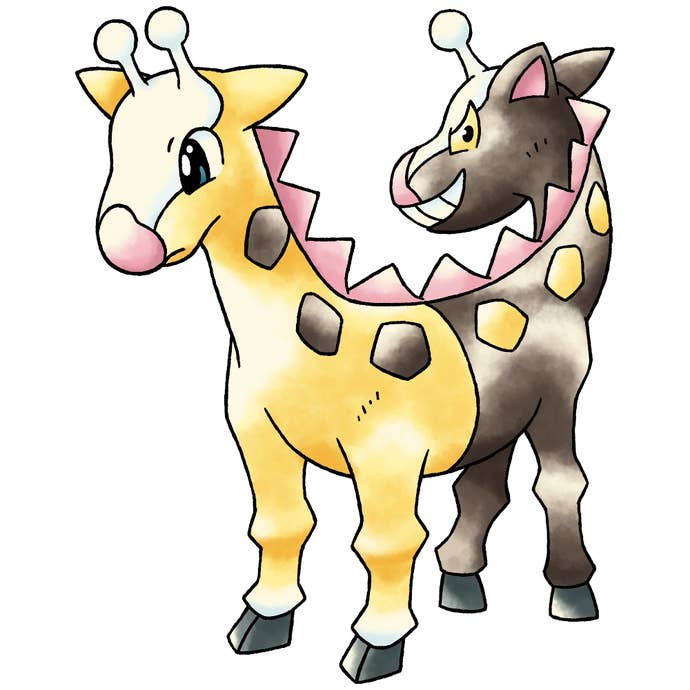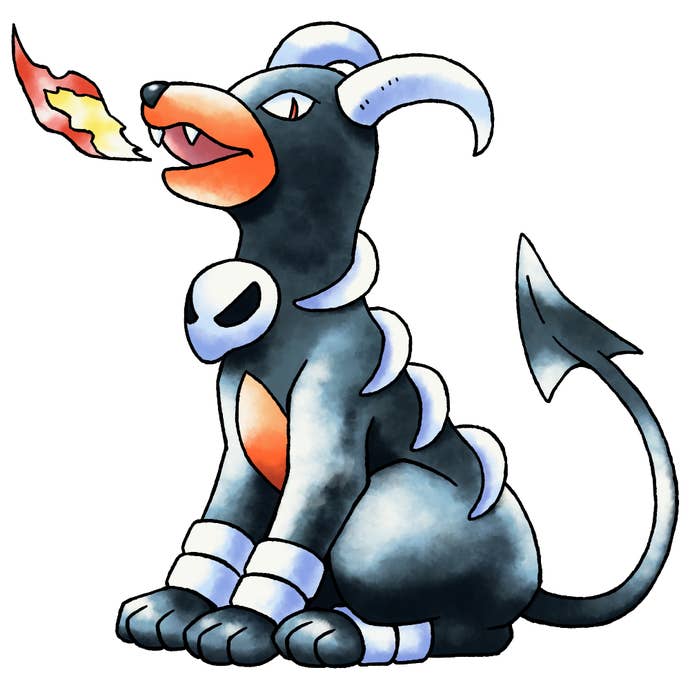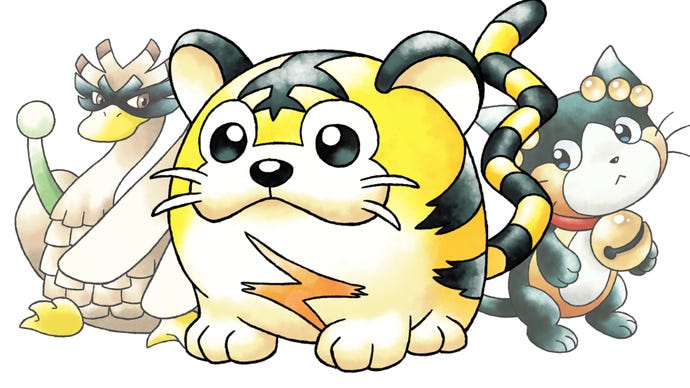PokeNecromancer: How An Artist Is Resurrecting "Lost" Pokemon With Amazing Illustrations
A little paint and imagination can lift a cold Pokemon from the cutting room floor and into fans' hearts.
This article first appeared on USgamer, a partner publication of VG247. Some content, such as this article, has been migrated to VG247 for posterity after USgamer's closure - but it has not been edited or further vetted by the VG247 team.
North American parents found themselves baffled when Pokemon took over pop culture in 1998 and exhibited staying power that was uncommon in the decade of throwaway fads like Furby . In retrospect, it's not a mystery why kids fell in love with Pikachu, Charizard, Bulbasaur, and Pokemon's other iconic monsters. Pokemon Red and Blue for the Game Boy offered an escape to a fantastic world where ten-year-olds have command over colorful creatures of all shapes and sizes. The concept alone was easy to love.
Interestingly, Pokemon's early allure was bolstered by the communication divide that yawned between Japan and the Western world at the time. When North America received Pokemon Red and Blue, Game Freak was already deep into Pokemon Gold and Silver's development. Rumors and leaks reached our shores without context, and since fans' attempts at translating Japanese content was spotty in the late '90s, they spun wild stories. An infamous example is "Pikablu," a god-like Pokemon that was, according to playground legend, hidden deep in Pokemon Red and Blue. The basis of the rumor was screenshots and art of Marill, a decidedly not god-like Water-type mouse from Pokemon Gold and Silver.
As silly as these fan-crafted legends of ultra-rare Pokemon were, they helped keep kids' interest in Pokemon burning hot while they waited for more games. For some long-term Pokemon fans, that fascination with "lost" Pokemon endures, especially now that our hyper-connected world has made it much easier to root out examples of unused Pokemon, beta designs, and other scraps of art and information that never wound up in any of the games.

Pokemon Lost, Imagination Found
Rachel Briggs, an artist based in Austin, Texas, has been a lost Pokemon enthusiast since the earliest days of the fandom. She currently draws "official" art of the unused beta Pokemon sprites posted on Twitter by Dr. Lava, a lost Pokemon history buff. Briggs' ability to give life to these scraps of pixel art is impressive. At a glance, you could easily assume her illustrations are the work of original Pokemon artist and designer Ken Sugimori.
Briggs has had plenty of time to perfect her Pokemon art; the games came out when she was 12, and she and her friends immediately started drawing fanart. "I'm a huge fan of weird animals, real or fake, zoology is just endlessly fascinating to me," she says. "I grew up reading everything I could about birds, dinosaurs, bugs, dragons, gryphons, cryptids, whatever. I was the kind of kid who tried to befriend random wild animals, and I grew up on Nintendo, so the idea of a game where you could tame all these weird chimeras felt laser-targeted to my interests. I got a Game Boy Color and Blue version that Christmas and have been a die-hard fan ever since."
Briggs' love for Pokemon games wasn't limited to its core concept and art. She was the perfect age to absorb playground lore about the "lost god" Pokemon that supposedly lurked in the depths of Pokemon Red and Blue's code.
"Back in Gen 1, there were countless playground rumors about hidden Pokemon, 'PokeGods' which were evolutions of existing designs, and so on. These rumors were heavily fueled by things like the infamous MissingNo glitch and the glimpses we got of legitimate Pokemon which couldn't be obtained with normal gameplay such as Mew and Ho-oh," she says. "The fact that the internet and data rips weren't widespread yet contributed to the tenacity of these types of rumors, it really felt like anything could be lurking in the games just waiting to be discovered."

Briggs' love for Pokemon's mysteries eventually led her to the company of Dr. Lava, and the two function as a great team to this day. The most popular (and adorable) fruits of their team-up is the "Kotora" line, a cancelled three-stage evolution of a thunder tiger that appeared in the 1997 Spaceworld demo of Pokemon Gold and Silver.
Kotora has never appeared in any official Pokemon games, but with its melting eyes and big ol' paws, a lot of Pokemon fans—including Briggs—wishes it would. But the initial meeting between Briggs and Dr. Lava was a little turbulent thanks to an unorthodox unveiling of some lost Pokemon content.
Briggs is a member of Pokethon, a charity gaming marathon stream that raises donations while playing through all of the Pokemon games. She's also a member of Helix Chamber, a group of "Pokemon paleontologists" who research the development of the series. "In 2018, Helix Chamber was presented with unreleased assets from the development of the Gen 1 games, so we decided that I could spring it as a surprise for the entire fanbase at the February 2019 Pokéthon stream," she says. "We wanted to showcase how these assets could have looked in playable form, so I presented the reveals in the form of a modified Pokemon Blue ROM. As [Hitchhiker's Guide to the Galaxy author] Douglas Adams best put it, 'that made a lot of people very angry and was widely regarded as a bad move.'"
Indeed, fans didn't appreciate the lost assets' unique reveal. The modified Pokemon Blue ROM mixed fan sprites and fonts in with the official content, and viewers who just wanted the straight facts felt deceived. Helix Chamber was trying to have a bit of fun with the reveal, but the attempt proved less popular than a fistful of Drifloons at a child's birthday party. Helix Chamber quickly issued an apology.

Before things settled down, though, Dr. Lava wrote an article about the asset reveal and stream that upset Briggs because of what she "felt were inaccuracies about how the article described the stream." Dr. Lava responded kindly to her criticism and the two subsequently became friends. As the Pokemon franchise has shown us time and time again, even the fiercest of rivals can cooperate and achieve cool things.
Pokemon Necromancy Ain't Easy
Briggs is a talented artist who has her brushes in a lot of projects, but making "official" art of lost Pokemon presents a unique artistic challenge. Making illustrations based on Pokemon cut from the Spaceworld Silver and Gold demo isn't too difficult, as the demo retains plenty of information that helps Briggs bring it back to life (e.g. front and back sprites, Super Gameboy color palettes, and move information). It's a different story when Dr. Lava or Helix Chamber digs up ancient history about content cut from Pokemon Red and Blue, and Rachel is forced to work with bits and bobs.
"Recreating the Gen 1 MissingNos was very difficult because for the most part I only had low-resolution back sprites to work from," Briggs says. "If I was very lucky the corresponding front sprites can be glimpsed in the Satoshi Tajiri manga, or there was some leftover evolution and move data or so on.
"A good example of a really difficult design is Gorochu. We had been told about its existence in Game Freak interviews, but when we finally saw its back sprite it wasn't at all what anyone expected. We only recognized it as such because there was evolution data that linked it to Raichu! So, I had to come up with my interpretation to match the description given by Atsuko Nishida, and also the back sprite that we obtained, and still look plausibly like a Gen 1 Raichu evolution. I especially wanted it to look right because it's such a high-profile lost Pokemon."

Regardless of how difficult the Pokemon re-creation process proves to be, Briggs emerges with a design that's a dead ringer for Sugimori's distinctive watercolor style. Briggs admits Sugimori's influence has driven her creative process from the earliest days of her Pokemon fandom.
"Before I got my own copy of Pokemon, I would pore over the special Nintendo Power inserts, completely fascinated with Sugimori's artwork," she says. "Sugimori's style definitely influenced me quite a lot over the years though, so I don't find it to be a huge jump from my own whenever I try to purposefully imitate it."
Sugimori currently sits on the Board of the Pokemon company, and though he's still deeply involved in the Pokemon design process, it's rare to see his gentle watercolor style appear in art for modern Pokemon games. Despite this notable absence, last year's Pokemon Sword and Shield for the Switch introduced us to Galar Region Pokemon that still captured our hearts. Some of Briggs' favorites are the wide-eyed Dragon/Ghost-Type, Dreepy, the elephant-like Copperajah, and the lovely Ice/Bug-type, Frosmoth. Briggs makes an interesting observation about these beloved newcomers, though: Some resemble Pokemon cut from past generations.
One good example that Briggs notes is Dreepy's resemblance to the cut Gen 1 Pokemon, Crocky. Crocky is an unused wild-haired lizard Pokemon that only shows up in Satoshi Tajiri: The Man Who Created Pokémon, an educational manga from 2018.
"We also finally have an Indian elephant in the Cufant and Cooperajah line, and an elephant was one of the cut Gen 1 designs," Briggs says.

It's also worth pointing out that Gen 1's leek-bearing duck, Farfetch'd, had a planned evolution called "Madame" for Pokemon Gold and Silver. The swan-like evolution for Farfetch'd was cut, but we finally got an evolution for Farfetch'd in Sword and Shield. Admittedly, the noble and proud Sirfetch'd doesn't resemble Madame in any significant way.
When the Kotora Broke Free
Briggs describes herself as "perpetually busy," which is easy to believe. Her illustrations for Dr. Lava's lost Pokemon facts come in regularly, but it's just one of several art projects she balances at any one time.
"I swear my brain only runs right if I have some sort of project to work on," she says. "Lately, my more notable work includes some pixel art for Thylacine Studios' upcoming Siralim Ultimate, and I'm slowly putting together a design document for a personal project which will be a cute platformer with watercolor art based on the aesthetics of games like Kirby's Dreamland 3 and Mr. Gimmick, and Trip World."
Don't expect Briggs' love for lost Pokemon lore to sputter out any time soon, though. There seems to be no bottom to the digital well of lost Pokemon. Those sad, floating bits of unused pixels need a body, a history, and a name, and Briggs is happy to provide. It's her hope that some of the revived Pokemon might even make it into an official game someday—especially a certain electric tiger cub who's been overlooked more than once.

"I hope Game Freak has seen how much the fans love that little tiger and bring it back some day," she says. "They have [Sword and Shield] DLC. They could bring back Kotora at any time now."
Rachel Briggs uploads her lost Pokemon designs along with her other art on DeviantArt and Dropbox. You can also find her on Twitter at "RacieBeep."

